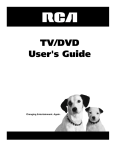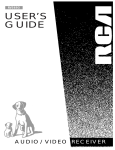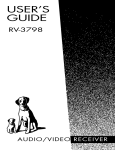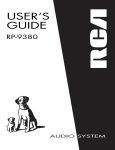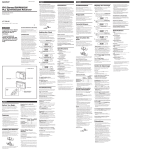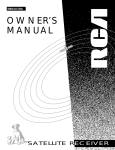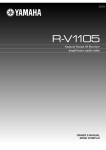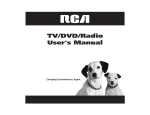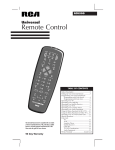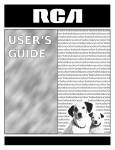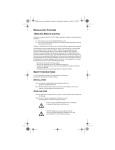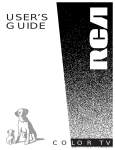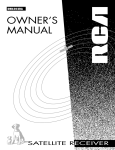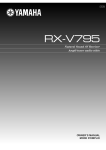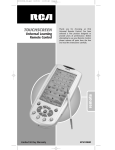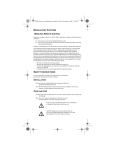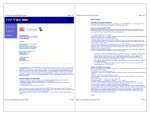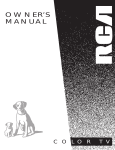Download Appendix A: Connecting the Receiver
Transcript
USER'S GUIDE RV-9900 RV-9950 AUDIO/VIDEO RECEIVER Safety Information WARNING RISK OF ELECTRIC SHOCK DO NOT OPEN TO REDUCE THE RISK OF ELECTRIC SHOCK, DO NOT REMOVE COVER (OR BACK). NO USER SERVICEABLE PARTS INSIDE. REFER SERVICING TO QUALIFIED SERVICE PERSONNEL. This symbol indicates "dangerous voltage" inside the product that presents a risk of electric shock or personal injury. This symbol indicates important instructions accompanying the product. Caution: To reduce the risk of electric shock, match wide blade of plug to wide slot, fully insert. Attention: Pour éviter les chocs électriques, introduire la lame la plus large de la fiche dans la borne correspondante de la prise et pousser jusqú au fond. Operate audio/video receiver only on 120 volts, 60 Hz AC power (normal house power). FCC Regulations state that unauthorized changes or modifications to this equipment may void the user’s authority to operate it. WARNING To reduce fire or shock hazard, do not expose this product to rain or moisture. Table of Contents First Things First ........................................................ 3 Operating the Receiver ........................................... 9 Tuning the Receiver ....................................................................... 10 Storing Stations in Memory ........................................................... 10 Preset Scanning .............................................................................. 11 Balancing the Speaker System ....................................................... 12 Using Swap Audio .......................................................................... 13 TOUR OF THE RECEIVER ................................................ 15 Front Panel ..................................................................................... 16 Front Panel Displays ....................................................................... 18 Remote Control .............................................................................. 19 Back Panel ...................................................................................... 24 Programming the Remote ................................... 25 Programming the Remote ............................................................. 26 Programming the Remote to Control a TV................................... 26 Programming the Remote to Control a VCR ................................ 28 Programming the Remote to Control An Audio Component .....30 Programming the Remote to Control a Cable Box ..................... 32 Programming the Remote to Control a Laserdisc Player ............ 34 Programming the Remote to Control A Satellite ........................ 35 Programming the AUX button on the Remote ............................ 35 Appendix A: Connecting Your Receiver ......... 37 Connecting a TV and a VCR ........................................................... 39 Connecting a Satellite Receiver ..................................................... 40 Connecting a Laserdisc Player ....................................................... 41 Connecting a Second VCR.............................................................. 42 Connecting a Camcorder or Video Camera .................................. 43 Connecting a Compact Disc Player ................................................ 44 Connecting a Tape Deck or Minidisc Player .................................. 45 Connecting Antennas .................................................................... 46 Connecting Speakers ..................................................................... 47 Appendix B: Speaker Placement ......................... 50 Appendix C: Troubleshooting Guide ............... 51 Appendix D: Care and Cleaning .......................... 52 Appendix E: FCC Information .............................. 53 Appendix F: Limited Warranty .......................... 54 Appendix G: Equipment Specifications ............ 55 Appendix H: Preset Station List Form .............. 56 Index .............................................................................. 57 1 2 First Things First Hi, my name is kim … The first section of this owner’s manual shows you how to use your audio receiver for the first time. The next three sections tell you about using the receiver’s controls and programming the remote. Use the last sections of the manual to connect your receiver to other components and as a general reference. If you have a specific question, refer to the table of contents or the index. Call RCA Consumer Relations for further questions. (see back cover) First Things First 2 Operating the Receiver 3 3 Tour of the receiver 4 Programming the Remote ➣ read the first four chapters 1 ➣ ...and I wrote this user manual along with the help of the engineers, designers and product managers. We worked hard to make sure that you have a rewarding experience using this RCA A/V receiver. PLEASE READ THE NOTES IN THE TEXT The engineers and designers gave me some great tips about this audio/video receiver. When a tip applies to the information on a page, I included it in a note box at the bottom of the page. READ ME… Note boxes like this one contain helpful and interesting information about using your audio receiver. 3 First Things First Step 1: Unpack the Receiver Unpack the receiver and the accessories. The accessories packed with the receiver include the RCA Remote (CRK67A1), 4 AAA cell batteries, an AM loop antenna, an FM “T” antenna, one paired (red/white) stereo cable, one single (yellow) video cable and Important Safeguards. Step 2: Connect the Receiver Before you plug in and turn on your audio/video receiver, connect the receiver to the components in your system and connect the speakers. The next two sections show how to connect the receiver to a TV and a VCR . If you are going to connect the receiver to a laserdisc player or other component, see Appendix A: Connecting the Receiver. For information on connecting your speakers, see Appendix A: Connecting the Receiver. For two suggestions on placing your speakers for the best sound, see Appendix B: Speaker Placement. 4 First Things First TV and VCR connection (TV without Audio output Jacks) This connection provides • stereo or surround sound from TV programs broadcast in stereo If your TV has more than one video input, make sure the VCR and VIDEO buttons tune the TV to the same channel that the receiver monitor out is plugged into. • stereo, surround sound or mono sound from a VCR • viewing one channel on TV while recording another channel Refer to the TV’s user’s guide for more information. To use this connection, you must have For additional video device connections, refer to Appendix A. • (1) paired (red/white) stereo cable • (2) coaxial cables CABLE BOX IN OUT OR ANTENNA To Connect 1. Connect the cables as shown in the diagram to the right. VCR IN FROM ANT IN CH3 CH4 OUT VIDEO R OUT TO TV L Using This Connection To watch TV programs TV 1. Turn off the VCR. 2. Press TV and tune to a channel. CABLE / ANTENNA To watch or play a tape on the VCR 1. Press VCR1 on your remote 2. Press PLAY. To record one program and watch another 1. Press VCR1 on your remote and tune to a channel. AUDIO RECEIVER VIDEO VCR IN OUT VIDEO MONITOR IN OUT 2. Begin recording. 3. Make sure TV/VCR switch on the VCR is set to TV. TAPE CD IN TV VCR OUT IN VIDEO OUT SUB WOOFER 4. Press TV and tune to a channel. AUDIO 5 First Things First TV and VCR (TV with Audio output Jacks) This connection provides • stereo or surround sound from TV programs broadcast in stereo If your TV has more than one video input, make sure the VCR and VIDEO buttons tune the TV to the same channel that the receiver monitor out is plugged into. • stereo, surround sound or mono sound from a VCR • viewing one channel on TV while recording another channel Refer to the TV’s user’s guide for more information. To use this connection, you must have For additional video device connections, refer to Appendix A. • (1) paired (red/white) stereo cable • (2) coaxial cables CABLE BOX IN OUT OR To Connect 1. Connect the cables as shown in the diagram to the right. VCR ANTENNA IN FROM ANT IN CH3 CH4 OUT VIDEO R OUT TO TV L Using This Connection To watch TV programs TV 1. Turn off the VCR. VIDEO INPUT 2. Press TV and tune to a channel. RIGHT OUT AUDIO S-VIDEO To watch or play a tape on the VCR IN CABLE / ANTENNA L/ MONO 1. Press VCR1 on your remote 2. Press PLAY. To record one program and watch another 1. Press VCR1 on your remote and tune to a channel. AUDIO RECEIVER VIDEO VCR IN TAPE CD IN TV VCR OUT IN 2. Begin recording. 3. Make sure TV/VCR switch on the VCR is set to TV. 4. Press TV and tune to a channel. 6 VIDEO AUDIO MONITOR OUT VIDEO OUT SUB WOOFER First Things First Step 3: Put Batteries in the Remote 1. Slide the battery compartment cover off the back of the remote. 2. Insert the 4 AAA batteries, matching the + and - ends of each battery with the symbols in the compartment. 3. Replace the cover. Step 4: Plug in the receiver Before you plug in the receiver, connect the other components and speakers. Plug the power cord in the wall outlet, matching the wide blade of the plug with the wide slot in the outlet. Be sure to insert the plug completely. Step 5: Turn on the receiver Press the POWER button on the receiver, the POWER button on the remote or any device button on the remote. Read on… The next section tells you how to operate the receiver. Then, read the section that takes you on a tour of the receiver and remote control. 7 8 Operating the Receiver If you have questions … 1 First Things First ➣ …about the front panel or remote control buttons as you go through this section, refer to Chapter 3, Tour of the Receiver. 2 Operating the Receiver ➣ 3 Tour of the receiver ➣ 4 Programming the Remote Important: In order to safeguard your hearing, turn the volume down before turning on your receiver. Also, unless otherwise specified, the buttons mentioned in this chapter are on the remote control. 9 Operating the Receiver Tuning the Receiver 1. Push the FM/AM button on the receiver (or the AM•FM button on the remote) to activate the tuner. 2. Press the FM/AM button on the receiver (or the AM•FM button on the remote) again to select the FM or AM band. Tuning Press the FF on your remote button to move up the AM or FM band. Press the REW button on your remote to move down the AM or FM band. Auto Tuning Use the AUTO feature to automatically search for stations of sufficient strength. Press AUTO on your receiver (or the INPUT•SEEK button on your remote) to put the receiver into AUTO mode. “AUTO” appears in the display. Press TUNING up or down button on the receiver to search. The tuner finds and stops on the next station whose frequency is strong enough to be received. To continue the search, press TUNING up or down button again. Storing Stations in Memory You can store up to 30 AM and FM stations. These stations can be stored in random order. To Store a Station 1. Press the FM/AM button on the receiver (or the AM•FM button on the remote) to turn on the receiver. 2. Select the band—FM or AM. 3. Select the station you want to store in memory using the methods described above. 4. Press the PROGRAM button on the remote. “MEMORY” blinks in the display. While “MEMORY” is blinking, press number buttons on the remote for the station. For stations 1, 2 or 3 press 0, then press 1, 2, or 3. For stations 4 through 30, press the numbers directly. 10 If the Memory indicator on the display turns off before you preset your station selection, press PROGRAM again. If the receiver is disconnected from its power source, the preset stations are maintained in memory for up to 7 days. OPERATING the Receiver To Play a Preset Station Press the appropriate Preset Stations number. For stations 1, 2 or 3 press 0, then press 1, 2, or 3. For stations 4 through 30, press the numbers directly. Or, press CHAN UP on your remote to tune to the next preset station or CHAN DOWN to tune to the previous preset station. Preset Scanning Use the PRESET SCAN button on the receiver’s front panel to review the preset stations stored in the tuner’s memory. “PRESET” and the station’s location in memory appear in the display. The tuner automatically scans all preset stations in order, pausing at each one for approximately 5 seconds. When the tuner reaches the station you want, press PRESET SCAN to stop the scanning. If the scan is not interrupted, the tuner reviews all preset stations in order, stopping at the point where the scan began. 11 OPERATING the Receiver Balancing the Speaker System To reproduce sound effects as they were intended, the speakers must be correctly balanced. To balance the speakers using the test tone, all speakers must be connected to your receiver. Your receiver must be in the Dolby Pro Logic Surround or Dolby 3 Stereo Mode. To balance the speakers 1. Press the TEST TONE button on the receiver front panel. The front panel displays show the current settings as the receiver generates “pink noise” and applies it automatically at 2-second intervals to the left main channel, center channel, right main channel, and left and right rear channels (simultaneously), in that order. 2. As the pink noise is generated, go to the spot in the room where you are most likely to be when listening to your system. The rear Surround sound and center speaker should be adjusted to equal the level of output from the left and right main speakers. 3. Make adjustments by pressing the REAR•CENTER button, and then the + or -button on your remote control. The output from the selected speaker(s) is adjusted accordingly. The adjustments will be indicated on the receiver’s display as they are made. Each time you press the + or - button on your remote control to adjust a channel, the receiver provides you with 2 more seconds of pink noise to that channel before moving on to the next. Also, the front panel displays reflect your adjustments. 4. Press the TEST TONE button again to end the test. You may not need to check or adjust these levels again unless you move your system, rearrange the speakers, or change your preferred seating location in the room. *Manufactured under license from Dolby Laboratories Licensing Corporation. “Dolby,” the double-D symbol , and “Pro Logic” are trademarks of Dolby Laboratories Licensing Corporation. 12 Fine tuning is best performed with the remote control so that adjustments can be made from the viewing or listening area. OPERATING the Receiver Using Swap Audio Swap audio lets you change the sound from the large picture to the small picture when you are watching TV and using picture-in-picture (PIP) with an external video source. To Use Swap Audio When you are watching TV and turn on PIP, you can turn on another video source and swap the sound from the large picture coming from the TV to the small picture coming from the other video source. 1. Press TV on the remote to turn on the TV and put the receiver in TV mode. 2. Press the PIP button. The empty PIP appears on the screen. 3. Activate a video source for the PIP. The picture from the video source appears in the PIP. 4. Press TV. 5. Change to the TV channel you want to watch on the large screen. 6. Press SWAP AUDIO to swap the sound between the large picture and the small picture. 7. To swap the video between the large picture and the small picture, use the SWAP PIP button on the remote. If you swap the TV picture to the PIP and the other video source to the large picture, you may not be able to swap the audio. To Change the Video Source and swap the audio If you want to change the video source for the PIP and want to be able to use SWAP AUDIO: 1. Turn off PIP. 2. Change the video source to another video component connected to the receiver. 3. Press TV to watch the TV. 4. Press PIP. The video source appears in the PIP. The video from the TV appears in the large picture. 5. Press SWAP AUDIO to swap the audio as you want. The Swap Audio feature may not work with all TV brands with the PIP feature. If your TV has a PIP feature, see the TV’s user’s guide for instructions for using it. 13 14 Tour of the Receiver Buttons and connections 1 First Things First ➣ This section describes the receiver’s controls and connections, including: • The front panel • The front panel display • The remote control the Receiver ➣ • The back panel 2 Operating 3 Tour of the Receiver ➣ 4 Programming the Remote As you operate the receiver, use the displays on the receiver’s front panel and the on-screen displays as references when you select options and adjust the sound to your satisfaction. 15 Tour of the Receiver MASTER VOLUME 16 14 12 18 10 REMOTE SENSOR 20 22 8 POWER 24 6 26 4 STANDBY/ON PRESET SCAN TUNING AU TO 28 2 1 0 2 3 4 5 6 7 8 30 0 9 BALANCE TREBLE BASS PHONES CD TAPE FM/AM TV VCR VIDEO L PRO LOGIC SPEAKERS 3 STEREO CENTER MODE HALL TEST TONE Front Panel AUTO Selects auto tuning mode or manual tuning mode. BALANCE Adjusts the sound from the left and right speakers. BASS Adjusts the bass listening level. BYPASS Turns off the Surround circuitry. Sound is generated without effects—conventional stereo. CD Selects the CD player input. CENTER MODE Lets you select a center mode when using Dolby Pro Logic or Dolby 3 Stereo: Normal Select if you are using a small center speaker. This is the recommended mode. Wide Select if the center speaker is large or the same as the left and right speakers. The full range of Center Channel is routed to the center speaker. Phantom Select when there is no center speaker. The signal intended for the center speaker is divided equally between the left and right main speakers. Phantom mode is not available in 3 Stereo mode. 3 STEREO Turns on Dolby Pro Logic surround sound without Surround sound speakers and is suggested for video, home theater, TV and some music. Recommended mode if not using surround speakers. PRO LOGIC Turns on Dolby Pro Logic surround sound with Surround sound speakers and is suggested for video, home theater, TV and some music. This is the recommended mode if you have all speakers. 16 BY PASS R MIN MAX MIN MAX Tour of the Receiver FM/AM Activates the tuner and selects the band. HALL Turns on Sound system without a center speaker and is suggested for classical music, jazz and other music. MASTER VOLUME Increases or decreases the volume. PHONES Provides a connection for headphones. POWER Turns the receiver on or off. PRESET SCAN Lets you review the preset stations. SPEAKERS Turns the speakers on and off. TAPE Selects the tape player as input. TEST TONE Turns on “pink” noise so that you can balance the speakers. Press again to turn off. TREBLE Adjusts the treble listening level. TUNING DOWN Moves down the selected FM/AM band. TUNING UP Moves up the selected FM/AM band. TV Selects the TV as input. VCR Selects VCR as input. VIDEO Selects the video equipment input (satellite, camcorder, etc.) 17 Tour of the Receiver REC DOLBY SURROUND PRO•LOGIC DOLBY 3 STEREO CENTER MODE TUNED STEREO MUTE FM AM NORMAL WIDE PHANTOM HALL BYPASS Front Panel Displays The receiver’s display panel shows the current status of the receiver and choices for some commands. Status Indicators AUTO Searches for AM or FM stations of sufficient signal strength. DOLBY 3 STEREO Dolby 3 Stereo mode is turned on. DOLBY PRO LOGIC SURROUND Dolby Pro Logic Surround mode is turned on. CENTER LEVEL DELAY TIME HALL Hall mode is turned on. KHz An AM station is selected. MEMORY The receiver is memorizing the frequency of the selected station. MHz An FM station is selected. MUTE The sound is muted. The MUTE symbol turns on in the front panel display when the sound is muted. NORMAL Normal mode is turned on. PHANTOM Phantom mode is turned on. PRESET A preset channel is channel selected. REAR LEVEL SPEAKERS OFF The speakers are turned off. STEREO An FM stereo signal is being received. TUNED The tuner had found a strong frequency in a search. WIDE Wide mode is turned on. 18 MEMORY MHz kHz AUTO DELAY TIME REAR CENTER PRESET mS dB ch SPEAKERS OFF Tour of the Receiver Remote Control Your RCA Remote Control is capable of operating most RCA audio and video equipment. To use the remote control effectively, always aim it directly at your receiver. The remote control operates on 4 AAA batteries, included with your system. Install them before attempting to operate the remote. Be sure to match the + and - ends of each battery to the symbols shown in the remote’s battery compartment. • VCR1 DSS CABLE TV POWER • VCR2 LD CD AM FM • TAPE AUX REW PLAY FF REC STOP Basic Controls MUTE Turns off the receiver’s sound. Press again to restore the sound. PAUSE CHAN SKIP CHAN PREV CH DISC 1 2 3 Receiver Controls 4 5 6 AM•FM Activates the tuner and toggles between the AM band and the FM band. 7 8 9 • GUIDE RDM DISPLAY ANTENNA 0 • CLEAR RESET REP DELAY CH CTRL MENU TV MENU MOVE PROGRAM PIP – + SWAP PIP •CTR CTR MODE BY-PASS SWAP AUDIO LEVEL SU SURROUND Lets you select a Surround Mode: Dolby Pro Logic Surround, Dolby 3-Stereo or Hall. Press once and the current mode appears. Press again to change the mode. • INPUT SEEK • ND DELAY/CH CTRL Selects the amount of Surround Sound delay between the main and rear speakers. When using Dolby Pro Logic Surround mode, choose from 15, 20 or 30 milliseconds. Press once and the current setting appears. Press again to change the setting. MUTE RE AR CTR MODE Changes the Center mode when using Dolby Pro-Logic Surround or Dolby 3 Stereo surround modes. Press once and the current mode appears. Press again to change the mode. VOL VOL UP and DOWN Increases or decreases the volume. VOL POWER Turns the AM/FM receiver off with two presses. If you have multiple components turned on and not the AM/FM receiver, pressing POWER once turns off the last component turned on. Pressing POWER again turns off all components. RROU 19 Tour of the Receiver SWAP AUDIO Swaps the audio only from the large picture to the small picture when you are watching TV and using picture-in-picture (PIP). Surround Sound Level Controls + Increases the volume in rear and center speakers. - Decreases the volume in rear and center speaker. BY-PASS Turns on ByPass mode, which cancels all Surround sound modes. Sound is generated without effects. REAR•CTR LEVEL Adjusts the balance level of the rear and center speakers. Press once for Center. Press again for Rear. Receiver/Tuner Controls CHAN UP and DOWN Tunes the receiver to the next or previous preset station stored in the receiver’s memory. FF Lets you manually move up the AM/FM band. INPUT•SEEK Selects auto tuning or manual tuning mode. MENU/PROGRAM Stores the selected station in the receiver’s memory. Number Buttons Let you enter numbers when needed. REW Lets you manually move down the AM/FM band. TV Controls + On some RCA TV models, used to adjust menu controls. - On some RCA TV models, used to adjust menu controls. ANTENNA Changes the antenna input. DELAY/CH CTRL In some RCA TV models, lets you control the channel that appears in the PIP window. CHAN UP and DOWN Tunes the TV channel up and down. CLEAR Removes any menu from the screen. DISPLAY Displays channel information. GUIDE•RDM For some models, brings up 12 small pictures (previews of the next 12 channels in the channel list). Press again to turn off channel guide. INPUT•SEEK For some TV models, toggles through the available input sources. 20 You can program the remote to operate many other brands of audio and video components. See Chapter 4, Programming the Remote for details. Tour of the Receiver MENU/PROGRAM For some models, stores channels in the TV’s memory. MOVE arrows In some models, when using PIP, moves the small picture to another corner of the screen. Also, used for menu navigation in some TV models. Number Buttons Let you enter channel numbers and time settings when needed. PIP Turns on and off picture-in-picture on most RCA TV models with PIP. POWER Turns the TV off. PREV CH•DISC Returns to the previous channel. RESET•REP Returns picture quality controls to their original settings. SKIP Press once before changing channels and the TV waits 30 seconds before returning to the original channel. Press repeatedly to increase the time. SWAP PIP Swaps the main picture in the PIP window. TV Turns on the TV and puts the remote in TV mode. TV MENU Displays the TV’s on-screen menus. VCR Controls CHAN up and down Tunes to the next or previous channel when watching TV through the VCR. CLEAR Resets the tape counter and corrects entries when programming the menus. DISPLAY Displays channel, time and counter information on the screen. FF Fast forwards a tape. Also, searches forward while a tape is playing. INPUT•SEEK For some VCR models, selects line input or tuner. MENU/PROGRAM Displays the on-screen programming menus. Number Buttons Let you enter numbers when needed. PAUSE Pauses a tape. PLAY Plays a tape. POWER Turns the VCR off. PREV CH•DISC Returns to the previous channel. REC Records a tape. If you have questions about the use of the remote buttons with another component, refer to the component’s user’s guide. 21 Tour of the Receiver REW Rewinds a tape. Also, searches backward while a tape is playing. SKIP Press once before changing channels and the TV waits 30 seconds before returning to the original channel. Press repeatedly to increase the time. STOP Stops a tape. VCR1 Turns on the VCR and puts the remote in VCR1 mode. VCR2•LD For some VCR models, if programmed, turns on a second VCR and puts the remote in VCR2 mode. LaserDisc Player Controls AUX If programmed, turns on another laserdisc player brand and puts the remote in laserdisc mode. CHAN up and down Changes to the next higher or lower track on the laserdisc. FF Scans forward on the laserdisc. Number Buttons Let you change to a specific track. PAUSE Pauses the laserdisc. PLAY Plays a laserdisc. POWER Turns the laserdisc player off. REW Scans backward on the laserdisc. STOP Stops the laserdisc. VCR2•LD For some laserdisc models, if programmed, turns on the laserdisc player and puts the remote in laserdisc mode. CD Player Controls AUX If programmed, turns on another CD player brand and puts the remote in CD mode. CD Turns on the CD player and puts the remote in CD mode. CLEAR Clears an entry when programming the CD player. DISPLAY In some CD models, lets you switch between the number track information and time information. GUIDE•RDM Activates the Random function, which plays a random selection of tracks from one or all CDs. FF Moves forward through the CD one track at a time. MENU/PROGRAM Programs the CD Changer to play up to 32 tracks in any order you choose. 22 Tour of the Receiver Number Buttons Let you enter numbers when needed. PAUSE Pauses the CD. PLAY Plays the CD. PREV CH•DISC Selects a disc to be played. Press PREV CH•DISC and then the CD number using the number buttons. RESET•REP Repeats a track, a CD or an entire program. Press once to repeat the currently playing track, twice for the CD or program, and three times to turn the function off. REW Moves backward through the CD one track at a time. STOP Stops the CD from playing. Tape Deck Controls AUX If programmed, turns on another tape deck brand and puts the remote in tape deck mode. FF Fast forwards the tape. Number Buttons Let you enter numbers when needed. PAUSE Pauses the tape. PLAY Plays the tape. POWER Turns the tape player off. REW Rewinds the tape. Satellite Receiver Controls AUX If programmed, turns on another satellite receiver brand and puts the remote in satellite receiver mode. CHAN up and down Tunes to the next or previous channel when watching TV through the satellite receiver. Number Buttons Let you enter numbers when needed. POWER Turns the satellite receiver off. Troubleshooting Guide Before referring to the checklist below, make sure you have correctly followed the connecting and operating procedures. If you have any questions that this booklet cannot answer, please call your nearest RCA dealer. 23 Tour of the Receiver ANTENNA VIDEO FM VCR IN OUT VIDEO MONITOR IN OUT AM LOOP TAPE CD IN TV VCR OUT IN VIDEO OUT SUB WOOFER L R AUDIO SPEAKERS (8Ω) R L R L REAR SPEAKERS (8 Ω) Back Panel AUDIO Connections Provides audio connections for components such as a VCR, TV, CD player, laserdisc player or tape player. IN Provides audio input from another component. OUT Sends audio output to another component, such as a minidisc, tape player or VCR. Sends a signal to the subwoofer. VIDEO Connections Provides video connections for the video portion of another component such as a VCR, TV or satellite receiver. IN Provides video input from another video component. OUT Sends video output to another video component such as a VCR. Monitor Out Sends video output to the TV. REAR SPEAKERS Provides connection for the rear Surround Sound speakers. CENTER SPEAKER Provides connection to the center speaker. FM Provides connection for an FM antenna. AM LOOP Provides connection for an AM antenna. 24 CENTER SPEAKER (8Ω) Programming the Remote If you want to use the remote with your TV or other component… ➣ 2 Operating the Receiver ➣ The remote already works with most other RCA, GE and ProScan TVs and VCRs. However, you can program the remote to control most brands of remote controllable TVs, VCRs, cable boxes, satellite receivers, and audio equipment. 1 First Things First 3 Tour of the Receiver ➣ 4 Programming the Remote 25 Programming the Remote Programming the Remote You can program the remote to control most brands of remote controllable TVs, VCRs and cable boxes. If you have an RCA, GE or ProScan VCR, you may not need to program the remote at all. Other manufacturer’s brands need to be programmed. Programming the Remote to Control a TV To determine whether you need to program the remote, turn on the TV, point the remote at the TV’s remote sensor and press TV. Then, press the POWER, or CHAN UP or DOWN button to see if the TV responds to the remote commands. If not, you need to program the remote. Follow these steps to program your remote to control your TV: 1. Turn on the TV. 2. Look up your TV brand and code number(s) in the code list on the next page or on the code sheet packed with your remote. 3. Press and hold the TV button on the remote. 4. Enter the three-digit code from the code list. 5. Release the TV button, then press POWER to see if the TV responds to the remote commands. If not, try pressing TV then POWER. 6. Repeat steps 3 through 5 using the next code listed for your TV brand until the TV responds to the remote commands. This remote may not operate all models of the brands shown. If a battery is removed from the battery compartment of the remote control, all control key functions will return to the original mode. 26 Programming the Remote Remote TV Codes Amtron ......................................... 064 JC Penney ........... 000, 008, 011, 019, 027, 040, 068, 077, 086, 088 Radio Shack ....... 000, 021, 025, 036, 037, 059, 064, 078 Akai ...................................... 002, 103 Jensen .................................. 011, 027 A-Mark ......................................... 102 JVC ...................... 012, 024, 036, 037, 040, 048, 051, 074 RCA ..................... 000, 006, 011, 019, 027, 034, 038, 044, 046, 088, 100, 101, 109 Kawasho ..................... 002, 011, 027 Realistic ........................................ 021 Kenwood ............ 006, 011, 014, 027 Sampo .................................. 011, 027 Kloss Novabeam ................. 035, 043 Samsung ............. 006, 011, 014, 015, 019, 027, 036, 037, 077, 110 Admiral ........................................ 005 Anam .................................... 104, 105 Anam National .................... 038, 106 AOC .................... 011, 019, 027, 088, 107 Bell & Howell .............................. 005 KTV ............................................... 078 Candle ......................... 011, 027, 033 Loewe ........................................... 013 Citizen ................. 011, 027, 033, 064 Luxman ................................ 011, 027 Colortyme ................... 011, 027, 084 LXI ....................... 000, 013, 018, 021, 023, 054 Sears ................... 000, 006, 011, 014, 017, 018, 021, 023, 027, 039, 040, 041, 051, 071, 083, 095 Contec/Cony ...... 036, 037, 040, 042, 064 Magnavox .......... 006, 007, 010, 011, 013, 016, 027, 033, 035, 043, 049, 066, 087, 089 Sharp .................. 011, 020, 025, 027, 037, 052, 053, 059, 060, 108 Craig ............................................. 064 Marants ........................................ 013 Curtis Mathes ............ 000, 011, 015, 027, 037 Marantz .............. 011, 013, 027, 069 Concerto .............................. 011, 027 CXC ............................................... 064 Daewoo ............... 011, 019, 027, 112 Daytron ................................ 011, 027 Dimensia ...................................... 000 Memorex ...................................... 005 Sanyo .. 017, 021, 039, 056, 057, 058 Scott ............................ 028, 037, 064 Signature ............................. 005, 094 Sony .............................................. 002 Soundesign ................. 011, 027, 033 MGA ................... 006, 011, 014, 019, 022, 027, 041, 056, 061, 068 Sylvania .............. 006, 007, 010, 011, 013, 016, 027, 033, 035, 043, 049, 066, 087, 089 Mitsubishi .......... 006, 011, 014, 019, 022, 027, 041, 055, 056, 061, 068 Symphonic ........................... 064, 076 Tatung .......................................... 038 Electrohome ...... 006, 011, 014, 027, 038, 061, 068 MTC ............................. 011, 019, 027 Emerson ............. 011, 026, 027, 028, 029, 030, 031, 032, 037, 042, 053, 064, 065, 067, 075, 076, 078, 079, 094, 095, 096 NAD ...................................... 018, 023 Envision ................................ 011, 027 Panasonic ... 012, 013, 038, 086, 111 Fisher ................... 017, 021, 039, 041 Philco .................. 006, 007, 010, 011, 013, 016, 019, 027, 033, 035, 037, 038, 043, 087, 089 Toshiba ............... 018, 021, 023, 040, 071, 077, 085, 090 Philips ................. 002, 006, 007, 010, 011, 013, 016, 033, 035, 037, 038, 043, 066, 073 Victor ............................................ 051 Funai ............................................. 064 GE ....................... 000, 008, 009, 011, 012, 027, 038, 068, 086, 089, 091 Goldstar ............. 003, 004, 006, 011, 019, 027, 037, 050 Hallmark .............................. 011, 027 Hitachi ................ 009, 011, 027, 036, 037, 040, 047, 048, 063, 080, 094, 097, 098 Infinity ......................................... 013 JBL ................................................. 013 Multivision ................................... 081 NEC ..................... 011, 014, 019, 027, 038, 084 Pioneer ............... 011, 027, 045, 062, 093 Technics ........................................ 012 Techwood ............................ 011, 027 Teknika ............... 011, 019, 027, 033, 036, 037, 040, 066 Telecaption .................................. 090 TMK ...................................... 011, 027 ............................................... 008, 009 Vidtech ................................. 019, 027 ProScan ........................................ 000 Wards ................. 000, 005, 006, 007, 008, 009, 010, 011, 013, 019, 025, 027, 028, 035, 043, 059, 066, 076, 082, 089 Proton ................. 011, 027, 037, 072 Yamaha ............... 006, 014, 019, 027 Quasar ......................... 012, 038, 092 Zenith ................................... 001, 099 Portland .............. 011, 019, 027, 037 27 Programming the Remote Programming the Remote to Control a VCR To determine whether you need to program the remote, turn on the VCR, point the remote at the VCR’s remote sensor, and press VCR1. Then, press the POWER or CHAN UP or DOWN button to see if the VCR responds to the remote commands. If not, you need to program the remote. Follow these steps to program your remote to control your VCR: 1. Turn on the VCR. 2. Look up your VCR brand and code number(s) in the code list on the next page or on the code sheet packed with your remote. 3. Press and hold the VCR1 button on the remote. 4. Enter the three-digit code from the code list. 5. Release the VCR1 button, then press POWER to see if the VCR responds to the remote commands. If not, try pressing VCR1 then POWER. 6. Repeat steps 3 through 5 using the next code listed for your VCR brand until the VCR responds to the remote commands. This remote may not operate all models of the brands shown. To program the VCR2•LD button to control a second VCR, follow these steps but use the VCR2•LD button instead of the VCR1 button. 28 Programming the Remote Remote VCR Codes Admiral ....................................... 006 Aiwa ............................................ 015 Akai .................. 003, 017, 022, 023, 063, 066 Audio Dynamics ................. 014, 016 Bell & Howell ............................. 002 Broksonic .................................... 010 Candle .............. 007, 009, 013, 044, 045, 046, 052 Canon .................................. 008, 053 Capehart ..................................... 001 Citizen .............. 007, 009, 013, 044, 045, 046, 052 Colortyme ................................... 014 Craig .................................... 007, 012 Curtis Mathes .. 000, 007, 008, 014, 015, 044, 046, 053, 064, 067 Daewoo .............. 013, 045, 052, 076 dbx ....................................... 014, 016 Dimensia ..................................... 000 Dynatech ..................................... 015 Electrohome ............................... 027 Emerson ........... 008, 009, 010, 013, 015, 020, 023, 027, 034, 041, 042, 047, 049, 057, 062, 065, 067, 068, 070 Fisher ................ 002, 012, 018, 019, 043, 048, 058 Funai ............................................ 015 GE ..................... 000, 007, 008, 032, 037, 053 Goldstar ............. 009, 014, 046, 060 Harman Kardon ......................... 014 Hitachi ................ 005, 015, 035, 036 Instant Replay ............................ 008 JCL ................................................ 008 JC Penney ......... 002, 005, 007, 008, 014, 016, 030, 035, 051, 053 JVC .................... 002, 014, 016, 030, 046, 074 Kenwood ......... 002, 014, 016, 030, Sanyo ................................... 002, 012 044, 046 Scott ................. 004, 013, 041, 049, KLH .............................................. 073 068 Lloyd’s ......................................... 015 Sears ................. 002, 005, 009, 012, 018, 019, 035, 043, 048 Logik ............................................ 031 Magnavox .......... 008, 029, 053, 056 Sharp ................ 006, 024, 027, 039, 045 Marantz ........... 002, 008, 014, 016, Shintom .............. 017, 026, 031, 055 029, 030, 044, 046, 061 Marta ........................................... 009 Signature .................................... 015 MEI ............................................... 008 Sony ............................ 017, 026, 038 Memorex ............ 008, 009, 012, 015 Sylvania ............ 008, 015, 029, 053, 056 MGA .................................... 004, 027 Symphonic .................................. 015 Midland ....................................... 032 Tandy ................................... 002, 015 Minolta ............................... 005, 035 Tashiko ........................................ 009 Mitsubishi ........ 004, 005, 027, 035, Tatung ......................................... 030 040 Montgomery Ward .................... 006 Teac ............................ 015, 030, 069 MTC ..................................... 007, 015 Technics ....................................... 008 Multitech ........... 007, 015, 031, 032 Teknika ............... 008, 009, 015, 021 NEC ................... 002, 014, 016, 030, TMK ............................................. 067 044, 046, 059, 061, 064 Toshiba ............. 005, 013, 019, 048, 049 Panasonic ........... 008, 053, 075, 077 Pentax ........................ 005, 035, 044 Totevision ........................... 007, 009 Pentex Research + ..................... 046 Unitech ........................................ 007 Philco .................. 008, 029, 053, 056 Vector Research ........ 014, 016, 044 Philips .................................. 008, 029 Victor ........................................... 016 Pioneer ....................... 005, 016, 050 Video Concepts ......... 014, 016, 044 Portland ..................... 044, 045, 052 Videosonic .................................. 007 ProScan ....................................... 000 Wards ............... 005, 006, 007, 008, 009, 012, 013, 015, 025, 027, 031, Quartz ......................................... 002 035 Quasar ................................. 008, 053 Yamaha ............ 002, 014, 016, 030, 046 RCA ................... 000, 005, 007, 008, 028, 035, 037, 054, 069 Zenith ................. 011, 017, 026, 072 Radio Shack/Realistic ...... 002, 006, 008, 009, 012, 015, 019, 027, 043, 053 Samsung ........... 007, 013, 022, 032, 042 Sansui .................................. 016, 071 29 Programming the Remote Programming the Remote to Control An Audio Component To program the remote for a remote-controllable audio component, point the remote at the component and press the correct component button: CD for a CD player, TAPE for a tape player, etc. Then, press POWER or CHAN UP or DOWN. If the component doesn’t respond, the remote needs to be programmed. Use the codes in the code list on the next page or on the sheet packed with your remote. Follow these steps to program your remote to control your audio component: 1. Turn on the component to be programmed. 2. Look up the brand and corresponding code number in the code list on the next page or on the code sheet packed with your remote. 3. Press and hold the component button on the remote. 4. Enter the three-digit code from the code list. 5. Release the component button, then press POWER to see if the component responds to the remote commands. If it doesn’t, try pressing the component button, then POWER again. 6. Repeat steps 3 through 5 using the next code listed for the brand of your component until the component responds to the remote commands. This remote may not operate all models of the brands shown. 30 Programming the Remote AUDIO Codes ads: AMP .................... 001 Aiwa: CD ....................... 060 Akai: AMP ............ 002, 008 Denon: CD ....................... 057 Dynamic Bass: AM/FM ................ 029 CD ....................... 025 TAPE ........... 026, 027 PHONO ............... 028 Emerson: CD ....................... 066 Fisher AMP .................... 023 CD ....................... 067 Hitachi: CD ....................... 063 JVC: AMP ............ 016, 058 AM/FM ........ 030, 035 CD ....................... 032 TAPE ........... 033, 034 AUX .................... 031 Kenwood: Kyocera: AMP ............ 017, 074 AM/FM ................ 074 CD ....... 067, 070, 077 TAPE ........... 071, 072 PHONO ............... 073 RCA: AMP .................... 024 AM/FM ................ 003 CD ....... 007, 043, 044 TAPE ................... 006 PHONO ............... 005 AUX ............ 004, 054 Realistic: CD ............... 063, 066 Sansui: CD ....................... 045 Scott: CD ....................... 066 TAPE ........... 055, 056 Sherwood: AMP ............. 011,013 Sony: AMP .................... 021 AM/FM ................ 049 CD ....................... 046 TAPE ........... 048, 053 PHONO ............... 047 Teac: AMP .................... 010 CD ....................... 069 Technics: AM/FM ................ 052 CD ....................... 050 TAPE ................... 051 Yamaha: AMP ............ 018, 019 AMP .................... 009 Lotte (NEC): CD ....................... 075 Magnavox: AMP .................... 065 AM/FM ................ 065 CD ....................... 061 Marantz: AMP ............ 022, 076 AM/FM ................ 076 CD ....................... 068 Mitsubishi: AMP ............ 015, 059 AM/FM ................ 059 Nakamichi: AMP .................... 020 Onkyo: AM/FM ................ 082 CD ....................... 078 TAPE ........... 080, 081 PHONO ............... 079 Panasonic: AMP .................... 012 AM/FM ................ 038 CD ............... 036, 083 TAPE ................... 037 Philips: AMP .................... 062 AM/FM ................ 062 CD ....................... 061 Pioneer: AMP .................... 014 AM/FM ................ 042 CD ....................... 039 TAPE ........... 040, 041 31 Programming the Remote Programming the Remote to Control a Cable Box Refer to the cable box connection page or contact your cable company to hook up your cable box. You may be able to program the remote for your remote controllable cable box. Use the codes in the code list on the right or on the sheet packed with your remote. 1. Turn on the cable box. 2. Look up the cable box brand and its code number(s) in the code list on the next page or on the code sheet packed with the remote. 3. Press and hold the DSS•CABLE button on the remote. 4. Enter the three-digit code from the code list. 5. Release the DSS•CABLE button, then press POWER or CHAN UP or DOWN to see if the cable box responds to the remote commands. If not, try pressing DSS•CABLE, then POWER again to see if the cable box responds. 6. Repeat steps 3 through 5 using the next code listed for the brand of your cable box until the cable box responds to the remote commands. This remote may not operate all models of the brands shown. 32 Programming the Remote Remote Controllable Cable Box Codes ABC ...................... 022, 046, 053, 054 Tocom ......... 017, 021, 049, 050, 055 Anvision ............................... 007, 008 Unika ........................... 031, 032, 041 Cablestar .............................. 007, 008 ...................................... 051, 052, 060 Diamond ...................................... 056 Viewstar ............. 007, 008, 019, 021, 026, 028, 029, 032, 033, 040, 041 Eagle ..................................... 007, 008 Eastern International ................. 002 General Instrument .................... 046 Warner Amex .............................. 044 Zenith .................. 014, 042, 057, 061 GI 400 ................. 004, 005, 015, 023, 024, 025, 030, 036 Hamlin ........ 003, 012, 013, 034, 048 Hitachi ......................... 037, 043, 046 Jerrold ................ 004, 005, 015, 023, 024, 025, 030, 036, 045, 046, 047, 062, 065 Macom ................................. 037, 043 Magnavox .......... 007, 008, 019, 021, 026, 028, 029, 032, 033, 040, 041 NSC ............................................... 009 Oak .............................. 001, 016, 038 Oak Sigma ................................... 016 Panasonic ............ 003, 027, 039, 061 Philips ................. 007, 008, 019, 021, 026, 028, 029, 032, 033, 040, 041 Pioneer ........................ 018, 020, 044 Randtek ................................ 007, 008 RCA ....................................... 000, 027 Regal ........................... 003, 012, 013 Regency ................................ 002, 033 Samsung ....................................... 044 Scientific Atlanta ...... 003, 022, 035, 063, 064 Signature ..................................... 046 Sprucer ......................................... 027 Starcom ........................................ 046 Stargate 2000 .............................. 058 Sylvania ................................ 011, 059 Teknika ......................................... 006 Texscan ........................ 010, 011, 059 33 Programming the Remote Programming the Remote to Control a Laserdisc Player You may be able to program your remote to control a laserdisc player. Use the codes shown to the right or on the sheet packed with your remote. Laserdisc Player Codes Pioneer ................................. 033, 037 ProScan ................................ 033, 037 RCA ....................................... 033, 037 Follow these steps to program your remote to control your laserdisc player: 1. Turn on the laserdisc player. 2. Look up the brand and its code number(s) in the code list. 3. Press and hold the VCR2•LD button on the remote. 4. Enter the three-digit code from the code list. 5. Release the VCR2•LD button, then press POWER to see if the laserdisc player responds to the remote commands. If it doesn’t, try pressing VCR2•LD, then POWER again. 6. Repeat steps 3 through 5 using the next code listed for your brand until the laserdisc player responds to the remote commands. This remote may not operate all models of the brands shown. 34 Programming the Remote Programming the Remote to Control A Satellite RECEIVER SATELLITE Receiver Codes Chaparral ............................. 080, 081 1. Turn on the satellite receiver. Cheyenne ..................................... 081 2. Look up the satellite receiver brand and corresponding code number(s) in the code list on the right. Drake .................................... 082, 083 3. Press and hold the DSS•CABLE button on the remote. 4. Enter the three-digit code from the code list. 5. Release the DSS•CABLE button, then press POWER or CHAN UP or DOWN to see if the receiver responds to the remote’s commands. If it doesn’t, try pressing DSS•CABLE, then POWER again. 6. Repeat steps 3 through 5 using the next code listed for the brand of your receiver until the receiver responds to the remote commands. RCA DSS ® System ........................ 000 General Instruments . 092, 093, 094 RCA ............................................... 000 Realistic ........................................ 084 Sierra I,II,III .................................. 081 STS1 .............................................. 085 STS2 .............................................. 086 STS3 .............................................. 087 STS4 .............................................. 088 Toshiba ......................................... 089 Uniden ......................................... 090 Video Cipher II ............................ 091 Programming the AUX button on the Remote You can program the AUX button on the remote to control another component. The AUX button can be used to control other brands of audio components, TVs, cable boxes, satellite receivers, and VCRs. To program the AUX button, follow these steps: 1. Turn on the component you want to program. 2. Look up the brand and corresponding code number(s) in one of the code lists on the previous pages. 3. Press and hold the AUX button on the remote. Then, press the other component button—AM/FM, TAPE, CD, DSS•CABLE, etc. 4. Release the component button, but not the AUX button. 5. Enter the three-digit code from the code list. 6. Release the AUX button, then press POWER or CHAN UP or DOWN to see if the component responds to the remote commands. If it doesn’t, press AUX, then POWER again. 7. Repeat steps 3 through 6 using the next code listed for the brand of your component until it responds to the remote commands. This remote may not operate all models of the brands shown. 35 36 Appendix A: Connecting the Receiver Things to know before connecting the components 1 First Things First 2 Operating the Receiver ➣ • Protect components from power surges. • Connect all components before plugging any power cords into the wall outlet. • Always turn off the receiver and/or components before you connect or disconnect any cables. RCA Phono Type Terminals Red for the right (R) channel. White for the left (L) channel. Yellow for the video (V). Black for the subwoofer. (Not Included) 3 Tour of the receiver 3 ➣ Speaker Terminals Red for positive (+) terminals. Black for negative (-) terminals. ➣ • Always make sure the color-coded plugs match the color of the terminals in which they are inserted. The connection cable plugs and jacks are color-coded as follows: 4 Programming the Remote • Some units may be supplied with connection plugs that are color coded red and black instead of red and white. In this case, the black plug takes the place of the white plug. • Contact Consumer Relations if you have questions concerning the connections of components. 37 Appendix A: Connecting the Receiver Position cables correctly to avoid audio hum or interference • Insert all cable plugs firmly into their jacks. • Place audio/video cables to the sides of the receiver’s back panel instead of straight down the middle after you connect the components. • Try not to coil any power cables and keep them away from the audio/video cables as much as possible. • Make sure all antennas and cables are properly grounded. Refer to the Safety Tips sheet packed with your receiver. Protect your components | from overheating • Do not block ventilation holes in any component. Arrange the components so that air can circulate freely. • Do not stack components directly on top of each other. • Allow adequate ventilation when placing your components in a stand. • Place an amplifier near the top shelf of the stand so heating air rising from it will not flow around other components. If you have a satellite receiver, you should place it on the top shelf. 38 Appendix A: Connecting the Receiver TV and VCR This connection provides • stereo or surround sound from TV programs broadcast in stereo • stereo, surround sound or mono sound from a VCR • viewing one channel on TV while recording another channel If your TV has more than one video input, make sure the VCR1 and VIDEO buttons tune the TV to the same channel that the receiver monitor out is plugged into. To use this connection, you MUST HAVE Refer to the TV’s user’s guide for more information. • (1) paired (red/white) stereo cables • (3) single (yellow) video cables • (2) coaxial cables CABLE BOX IN OUT To Connect 1. Connect the cables as shown in the diagram below. OR VCR ANTENNA IN FROM ANT IN CH3 CH4 OUT VIDEO R OUT TO TV L Using This Connection To watch TV programs 1. Turn off the VCR. VIDEO INPUT TV 2. Press TV and tune to a channel. RIGHT OUT AUDIO S-VIDEO To watch or play a tape on the VCR IN CABLE / ANTENNA L/ MONO 1. Press VCR1. 2. Press PLAY. To record one program and watch another 1. Press VCR1 and tune to a channel. VIDEO AUDIO RECEIVER VCR IN OUT VIDEO MONITOR IN OUT 2. Begin recording. 3. Make sure TV/VCR switch on the VCR is set to TV. TAPE CD IN TV VCR OUT IN VIDEO OUT SUB WOOFER L 4. Press TV and tune to a channel. R AUDIO 39 Appendix A: Connecting the Receiver Satellite Receiver This connection provides • stereo or surround sound from programs broadcast in stereo • stereo sound from the satellite receiver To use this connection, you must have • (1) paired (red/white) stereo cable • (1) single (yellow) video cable • (2) coaxial cables To Connect 1. Connect the cables as shown in the diagram below. Do not stack electronic components or other objects on top of the satellite receiver. The slots on top of the receiver must be left uncovered to allow proper airflow to the unit. Blocking the airflow to the unit could impair performance or damage your receiver and other components. Also, do not stack the satellite receiver on top of a “hot component” such as an audio power amplifier. Using This Connection To watch TV programs in stereo 1. Press TV and tune to a channel. SATELLITE DISH TO TV S-VIDEO To watch DSS programming 1. Press DSS•CABLE. 2. Tune to a channel. RCA DSS RECEIVER 3. Follow the instructions in the satellite receiver User’s Guide. IN FROM ANT CH3 CH4 S-VIDEO OUT TO TV L R VIDEO AUDIO SATELLITE IN VIDEO VCR AUDIO RECEIVER IN TAPE CD IN L R 40 OUT VCR OUT VIDEO MONITOR IN OUT VIDEO OUT SUB WOOFER Appendix A: Connecting the Receiver Laserdisc Player You can connect a laserdisc or a second VCR to the VIDEO connection. Using this connection, you can play a laserdisc in stereo, surround sound. This connection provides • stereo or surround sound from the laserdisc To use this connection, you MUST HAVE • (1) paired (red/white) stereo cable • (1) single (yellow) video cables To Connect 1. Connect the cables as shown in the diagram below. Using This Connection To play the laserdisc 1. Press VCR2•LD. 2. Press PLAY. LASERDISC PLAYER L R VIDEO MONO AUDIO RECEIVER VIDEO VCR IN TAPE CD IN OUT TV VCR OUT IN L VIDEO IN VIDEO OUT MONITOR OUT SUB WOOFER L R R L AUDIO 41 Appendix A: Connecting the Receiver Second VCR Using this connection enables you to play a video tape but not record a tape. This connection provides • stereo, surround sound, or mono on the VCR • VCR playback only To use this connection, you MUST HAVE • (1) paired (red/white) stereo cable • (2) single (yellow) video cable To Connect 1. Connect the cables as shown in the diagram below. Using This Connection To play a tape on the second VCR IN FROM ANT SECOND VCR 1. Press VCR2•LD. CH3 CH4 S-VIDEO L 2. Press PLAY. TV OUT TO TV R VIDEO AUDIO VIDEO INPUT RIGHT OUT AUDIO S-VIDEO IN CABLE / ANTENNA L/ MONO AUDIO RECEIVER VIDEO VCR IN TAPE CD IN TV VCR OUT IN L L R R L AUDIO 42 OUT VIDEO IN VIDEO OUT MONITOR OUT SUB WOOFER Appendix A: Connecting the Receiver Camcorder or Video Camera If your camcorder or video camera does not have an RCA type terminal for audio/video, you can purchase an adapter from an RCA dealer or electronics parts store. This connection provides • stereo sound if the camcorder records or plays in stereo To use this connection, you MUST HAVE • (1) paired (red/white) stereo cable • (2) single (yellow) video cable To Connect 1. Connect the cables as shown in the diagram below. VIDEO If the VIDEO connection is being used, connect the camcorder or video camera to any other available video input. AUDIO L R Using This Connection To play the camcorder AUDIO RECEIVER VIDEO VCR IN 1. Turn on the camcorder or video camera. VIDEO IN MONITOR OUT R 2. Press VCR2•LD. TAPE CD IN 3. Press PLAY on the camcorder or video camera. OUT L TV OUT IN VCR OUT VIDEO SUB WOOFER R R AUDIO TV VIDEO INPUT RIGHT OUT AUDIO S-VIDEO L/ MONO IN CABLE / ANTENNA 43 Appendix A: Connecting the Receiver Compact Disc Player This connection provides • Stereo or surround sound, if available To use this connection, you MUST HAVE • (1) paired (red/white) stereo cable To Connect 1. Connect the cables as shown in the diagram below. Using This Connection To play a CD 1. Turn on the CD player, if the remote is not programmed to control the CD player. 2. Press CD to put the receiver in CD mode. 3. Press PLAY. The AUDIO SOURCE connection can be used as input for any stereo audio signal. CD PLAYER L R AUDIO RECEIVER VIDEO VCR IN TAPE CD IN TV VCR OUT IN L R R AUDIO 44 OUT VIDEO MONITOR IN OUT VIDEO OUT SUB WOOFER Appendix A: Connecting the Receiver Tape deck or Minidisc player This connection provides • Stereo or surround sound, if available To use this connection, you Must have • (2) paired (red/white) stereo cables To Connect 1. Connect the cables as shown in the diagram below. Using This Connection To play a tape 1. Press TAPE. 2. Press PLAY. To record a tape 1. Turn on the audio source you want to record. 2. Press RECORD on the tape player. TAPE DECK To play a minidisc IN OUT L L R R 1. Press TAPE. 2. Press PLAY. AUDIO RECEIVER VIDEO VCR IN TAPE CD IN TV VIDEO OUT VCR OUT IN IN VIDEO OUT MONITOR OUT SUB WOOFER L R AUDIO 45 Appendix A: Connecting the Receiver Antennas Extend the FM antenna to its full length and adjust it for the best reception. After you adjust the AM antenna, place it on a level surface or attach it to a wall using the holes in the antenna’s base. This connection provides • stereo sound from FM stations • mono sound from AM stations To use this connection, you MUST HAVE • (1) FM “T” antenna • (1) AM loop antenna To Connect 1. Connect the cables as shown in the diagram below. Using This Connection To listen to the radio 1. Turn on the receiver. FM “T” Antenna 2. Select a band (AM/FM). 3. Turn to the desired frequency. ANTENNA 4. Adjust the position of the antenna as needed. FM AM LOOP AM Loop Antenna 46 Appendix A: Connecting the Receiver CENTER AND SURROUND Speakers Connecting Speakers to the Receiver 1. If necessary, remove the vinyl covering from the ends of the speaker wire and twist the wire. 2. Press down and hold the lever on the speaker terminal. 3. Insert the wire in the hole. Be sure to connect the (+) to (+) and the (-) to (-). Otherwise, the speakers will not be “in phase”, causing reduction in bass frequencies. 4. Release the lever. Pull gently on the wire to make sure it is secure. TO CONNECT 1. Connect the cables as shown in the diagram below. SURROUND SOUND SPEAKER SURROUND SOUND SPEAKER CENTER CHANNEL SPEAKER AUDIO RECEIVER SPEAKERS (8Ω) R L R L CENTER SPEAKER (8Ω) REAR SPEAKERS (8 Ω) 47 Appendix A: Connecting the Receiver PASSIVE SUBWOOFER Connecting Speakers to the Receiver 1. If necessary, remove the vinyl covering from the ends of the speaker wire and twist the wire. 2. Press down and hold the lever on the speaker terminal. 3. Insert the wire in the hole. Be sure to connect the (+) to (+) and the (-) to (-). Otherwise, the speakers will not be “in phase”, causing reduction in bass frequencies. 4. Release the lever. Pull gently on the wire to make sure it is secure. TO CONNECT 1. Connect the cables as shown in the diagram below. A/V Receiver or Television + _ + _ Speaker + R L +R_ +L _ Speaker _ + +R_ +L _ Subwoofer 48 _ Appendix A: Connecting the Receiver POWERED SUBWOOFER Connecting Speakers to the Receiver 1. If necessary, remove the vinyl covering from the ends of the speaker wire and twist the wire. 2. Press down and hold the lever on the speaker terminal. 3. Insert the wire in the hole. Be sure to connect the (+) to (+) and the (-) to (-). Otherwise, the speakers will not be “in phase”, causing reduction in bass frequencies. 4. Release the lever. Pull gently on the wire to make sure it is secure. TO use this connection, you must have • (1) paired (red/white) stereo cable • (4) speaker wires (Only if your receiver does not have a subwoofer output jack) TO CONNECT 1. If your receiver has a subwoofer output jack, you will need to connect your receiver as shown in the diagram below. SUBWOOFER RECEIVER SUBWOOFER INPUT L/ MONO SUBWOOFER OUT R 49 Appendix b: Speaker placement Speaker Placement These diagrams offer suggested speaker placements that can enhance your home theater experience. Place the subwoofer anywhere you want. Example 1 Main Left Main Right TV Center Opt. Subwoofer This five-speaker configuration is an effective option for recreating in any room the full cinema experience. It can be adapted to suit your taste and listening space. This fivespeaker configuration is an effective option for Dolby Pro Logic Surround sound applications. Rear Right Example 2 This configuration is recommended for four speakers. It provides Dolby Pro Logic Surround sound without a center speaker. Choose Phantom for the Center mode. Opt. Subwoofer Rear Left Main Left Rear Left 50 TV Main Right Rear Right Appendix c: Troubleshooting Receiver/Tuner Operation STEREO indicator is off. • Adjust the antenna. • The signal is too weak. Connect an external antenna. • The signal is Mono. Severe hum or noise. • The signal is too weak. Connect an external antenna. • Adjust the antenna. Remote Control Operation The remote control does not operate the unit. • Another function is selected on the remote. Press the correct function button. • The batteries are exhausted. Replace all batteries. • The remote is not pointed at the remote control sensor on the main unit or there is an obstacle between the remote and the main unit. • The remote control is too far from the main unit. Move closer. General No audio. • Make sure the MUTE indicator on the front panel is off. • Make sure the speakers are turned on. • Check the connections. • Check the power cord connection. No audio from one channel. • Adjust the balance control. • Check the speaker wire connection or connecting cable. Noise when the TV is turned on. • The TV is too close to the audio system. Specific instruments sound displaced. 51 Appendix d: Care and Cleaning Care and Cleaning Unplug AC power cord before cleaning. Use a polishing cloth or other clean, dry cloth to wipe off dust and dirt. When the surface is very dirty, wipe with a soft cloth dipped in a mild soap solution. Do not use furniture wax or cleaners. Never use alcohol, paint thinner, benzene, or a chemically treated cloth to clean your system. Chemicals may damage the finish on the unit. When using a damp cloth, make sure you squeeze out as much of the water as possible. 52 Appendix e: FCC Information FCC Information In accordance with FCC requirements, changes or modifications not expressly approved by Thomson Consumer Electronics could void the user’s authority to operate this product. Important Information Required by Federal Communications Commission Concerning Radio Frequency Interference: This device complies with Part 15 of the FCC Rules. Operation is subject to the following two conditions: (1) This device may not cause harmful interference, and (2) This device must accept any interference received, including interference that may cause undesired operation. If this equipment does cause interference to radios or televisions not connected to your system, try to correct the interference with one or more of the following measures: • Reorient the receiving antenna (that is , the antenna for the radio or television that is, “receiving” the interference). • Change the position of the unit with respect to the radio or television equipment that is receiving the interference. • Move the unit away from the equipment that is receiving the interference. • Plug the unit into a different wall outlet so that the unit and the equipment receiving the interference are on different branch circuits. If these measures do not eliminate the interference, please consult with your dealer or an experienced radio/television technician for additional suggestions. Also, the Federal Communications Commission has prepared a helpful booklet, “How to Identify and Resolve Radio and TV Interference Problems.” This booklet is available from the U.S. Government Printing Office, Washington, D.C. 20402. Please specify stock number 004-000-00345-4 when ordering copies. 53 Appendix F: Limited Warranty Limited Warranty What your warranty covers: • Any defect in materials or workmanship. For how long after your purchase: • Two years. (The warranty period for rental units begins with the first rental or 45 days from date of shipment to the customer, whichever comes first.) What we will do: • Provide you with a new, or at our option, a refurbished unit. • The exchange unit is under warranty for the remainder of the original product’s warranty period. How to make a warranty claim: • Properly pack your unit. Include any cables, etc., which were originally provided with the product. We recommend using the original carton and packing materials. • Include in the package evidence of purchase date such as the bill of sale. Also print your name and address and a description of the defect. Send standard UPS or its equivalent to: Thomson Consumer Electronics, Inc. Product Exchange Center 32 Spur Drive El Paso, Texas 79906 • Pay any charges billed to you by the Exchange Center for service not covered by the warranty. • A new or refurbished unit will be shipped to you prepaid freight. What your warranty does not cover: • Customer instruction. (Your Owner’s Manual provides information regarding operating instructions and user controls. For additional information, ask your dealer.) • Installation and set-up service adjustments. • Batteries. • Damage from misuse or neglect. • Products which have been modified or incorporated into other products. • Products purchased or serviced outside the USA. • Acts of God, such as but not limited to lightning damage. Product Registration: • Please complete and mail the Product Registration Card packed with your unit. It will make it easier to contact you should it ever be necessary. The return of the card is not required for warranty coverage. How state law relates to this warranty: • This warranty gives you specific legal rights, and you may have other rights which vary from state to state. If you purchased your product outside the USA: • This warranty does not apply. Contact your dealer for warranty information. 54 Appendix g: Equipment Specifications Equipment Specifications Amplifier Section Left/Center/Right (at 8 Ω): Rear Surround (at 8 Ω): RV-9900 RV-9950 30 watts/30 watts/30 watts 50 watts/50 watts/50 watts 1% THD @ 1 KHz RV-9900 RV-9950 15 watts/15 watts 20 watts/20 watts 1% THD @ 1 KHz 50dB 40-20 kHz +/– 3 dB Muting Attenuation: Frequency Response Video Section Input (Sensitivity/Impedance): Output (Level/Impedance): Frequency Response for Signal to Noise Ratio: Crosstalk @ 3.58 MHz: 1 Vp-p/75 Ω 1 Vp-p/75 Ω 10 Hz to 6MHz at +/- 3 dB 40 dB 40 dB AM Tuner Section Frequency Response: Usable Sensitivity: Signal to Noise : Image Ratio: IF Rejection: 80 Hz -2 kHz +/– 6 dB 55 dBm 38 dB 27 dB @ 1000 kHz 35 dB FM Tuner Section Frequency Response: 50 dB Quieting Signal to Noise: Image Ratio: IF Rejection: 50 Hz-15 kHz +/– 6 dB 24 dBu 60 dB 40 dB @ 1000 kHz 50 dB Specifications are based on nominal measurements. Manufactured under license from Dolby Laboratories Licensing Corporation. “Dolby,” the double-D symbol , and “Pro Logic” are trademarks of Dolby Laboratories Licensing Corporation. 55 APPENDIX h: PRESET STATION LIST Form Preset Number 1 2 3 4 5 6 7 8 9 10 11 12 13 14 15 16 17 18 19 20 21 22 23 24 25 26 27 28 29 30 56 Band Frequency Notes Index Symbols + button 19 - button 19 A AC outlets 38 Accessories included 4 AM•FM button 19 AM/FM antennas, connecting 46 AM/FM button 10, 16 ANTENNA button 19, 22 Antennas, connecting 46 Audio codes for programming the remote 31 Audio hum, reducing 38 AUDIO SWAP button 13, 19 AUTO button 16 Auto Indicator 18 B Back panel 24 BALANCE control 16 Balancing speakers 12 BAND button 10, 16 Basic controls on the remote 19 BASS control 16 Batteries, inserting in the remote 7 BYPASS button 19 Bypass mode, selecting 16 C Cable box codes for programming the remote 32 Camcorder, connecting 43 Care and Cleaning 52 CD button 16, 22 CD player connecting 44 controls on the remote 22 CENTER button 16 CENTER MODE button 16 Center modes Normal 16 Phantom 16 Wide 16 CH CTRL/DELAY button 19 CHAN up and down buttons 19, 21, 22 CLEAR button 19, 21, 22 Components 38 Connecting components 37 things to know before connecting 37 Connections Antennas 46 Camcorder 43 CD player 44 Laserdisc 41, 42 Minidisc player 45 RCA DSS® Receiver 40, 46 Second VCR 41, 42 Tape deck player 45 TV and VCR 6, 39 Video Recorder 43 CTR MODE button 19 D DELAY button 16 DISPLAY button 19, 21, 22 Dolby 3 Stereo, selecting 16 Dolby Pro Logic Surround, selecting 16 Dolby Pro Logic Surround, turning off and on 16 DSS button 16 DSS•CABLE button 22 E Equipment specifications 55 F FF button 19, 21, 22, 23 Front panel buttons 16 Front panel displays 18 Status indicators 18 G GUIDE•RDM button 22, 23 H Hall mode, selecting 16 headphones connecting 30, 32, 34, 35, 40 using without the main speakers 30, 32, 34, 35, 40 57 Index I R INPUT•SEEK button 19, 21 Normal, Center Mode 16 Number buttons 19, 21, 22, 23 RCA DSS® Receiver connecting 40 controls on the remote 22 REAR•CTR Level button 19 REC button 21 Receiver controls on the remote 19 Remote 20, 21, 22 Basic Controls 19 CD player controls 22 inserting batteries 7 Laserdisc controls 22 programming 27, 32 RCA DSS® Receiver controls 22 Receiver Controls 19 Receiver/Tuner controls 20, 21, 22 surround sound level controls 19 tape deck controls 23 TV Controls 20 VCR Controls 21, 22 Remote control buttons 19 RESET•REP button 21, 23 REW button 19, 21, 22, 23 P S P. SCAN button 10, 16 PAUSE button 21, 22, 23 Phantom, Center Mode 16 PHONES connection for headphones 17 PIP audio swap 13 button 19, 21 PLAY button 19, 21, 22, 23 POWER button 16, 19, 21, 22, 23 PRESET indicator 18 Preset stations list 56 playing 10 setting 11 PREV CH•DISC button 19, 21, 22, 23 PROGRAM button 10 Programming the remote to control a cable box 32 Laserdisc 34 TV 26, 28 VCR 28 SKIP button 21 SPEAKER button 16 Speaker terminals, matching 37 Speakers 12 balancing 12 placing 50 turning off when using headphones 30, 32, 34, 35, 40 turning on and off 30, 32, 34, 35, 40 SPEAKERS OFF indicator 18 Specifications, equipment 55 Stations preset 10 storing in memory 10, 11 Status indicators on the front panel 18 STEREO indicator 18 STOP button 21, 22, 23 Storing stations in memory 11 Subwoofer, connecting 37 SURROUND button 19, 21 SURROUND SOUND button 16 Surround sound level controls on the remote 19 SWAP PIP button 21 L Laserdisc codes for programming a remote 34 connecting 41, 42 controls on the remote 22 LEVEL button 16 M MEMORY indicator 18 MENU•PROGRAM button 21 MENU/PROGRAM button 19, 23 Minidisc player, connecting 45 MOVE arrows 20, 22 MUTE button 19, 20 MUTE indicator 18 N 58 Index Switched AC outlet 38 T Tape deck connecting 45 controls on the remote 23 TAPE/MD button 16 TEST TONE button 16 TREBLE control 16 TUNING knob 16 Tuning the receiver 10 Turning off Dolby Pro Logic 16 TV codes for programming the remote 27 connecting 6, 39 controls on the remote 20 TV button 16, 21 TV MENU button 21 V VCR codes for programming the remote 29 connecting 6, 39, 41, 42 controls on the remote 21, 22 VCR1 button 16, 21, 23 VCR2•LD button 21, 22, 23 VOL up and down buttons 19, 21, 23 W Wide, Center Mode 16 59 NOTES 60 NOTES 61 For your nearest RCA Home Entertainment Dealer or Authorized Servicenter, all toll-free in the USA. 1-800-336-1900 If your product needs service, please contact your dealer or the nearest Servicenter from the yellow pages. Please do not send any products to the Indianapolis address listed in this manual or on the carton. This will only add delays in service for your product. 10330 North Meridian Street Indianapolis, IN 46290-1024 ©1996 Thomson Consumer Electronics, Inc. Trademark(s)® Registered Marca(s) Registrada(s) Printed in Korea Model Number RV-9900/RV-9950 Part Number 347A8239-0001 (Rev. 01)
































































